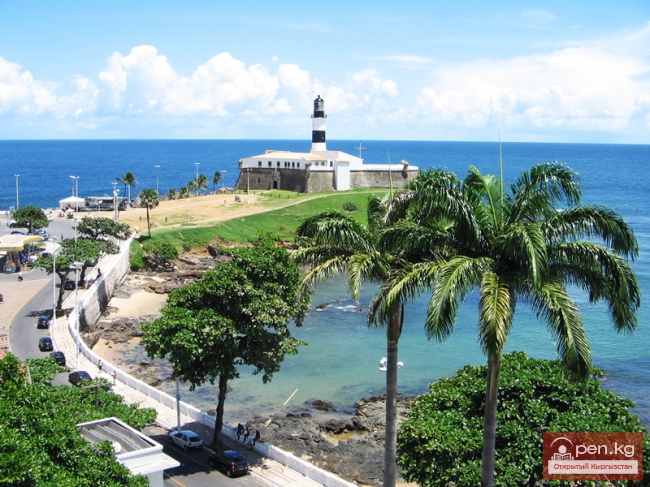NAMIBIA. Republic of Namibia
A country in the southwestern part of Africa, bordered by the Atlantic Ocean. Area - 824.3 thousand km². Capital - Windhoek (population 300 thousand). Administrative division - 13 regions. Population - 1.83 million (2004); 100 thousand of European descent (of which about 35 thousand are Germans). The largest African ethnic groups are Ovambo (about 48% of the country's population), Herero, Damara, Nama, and Kavango. The official language is English, with Afrikaans and German also widely spoken. The predominant religion is Christianity (90%), including 51% Lutherans, 19% Catholics, and the rest adhere to local traditional beliefs. The currency is the Namibian dollar.
It has diplomatic relations with the Russian Federation (established with the USSR on March 21, 1990).
National holiday - March 21 - Independence Day (1990).
Namibia is a republic. The constitution of 1990 is in effect. The head of state is President Hifikepunye Pohamba (since March 2005), elected by universal direct suffrage for a term of 5 years (the last elections were in November 2004).
The executive power is exercised by the president and the government. The Prime Minister is Nahas Angula (since 2005).
The highest legislative body is a bicameral parliament, consisting of the National Assembly (72 deputies elected by universal direct suffrage for a term of 5 years; the last elections were in November 2004) and the National Council (26 representatives of the regions, reformed in 2004).
Political parties: The South West Africa People's Organization (SWAPO) - founded in 1960, led the struggle for Namibia's independence and, having received 57% of the votes in the first general elections in November 1989, became the ruling party (in the 2004 elections - 55 seats in the National Assembly). The party chairman is H. Nuyoma. The National Assembly also includes 5 opposition parties: Congress of Democrats (5 seats), Democratic Alliance Turnhalle (4 seats), Republican Party (1 seat), United Democratic Front (3 seats), National Union of Democratic Organizations (3 seats), and the Monitor Action Group (1 seat).
The largest trade union association is the National Union of Namibian Workers.
Namibia (formerly known as South West Africa until 1968) was declared a German protectorate in 1884. In 1915, it was occupied by South African troops, and in 1920, it was placed under the administration of the Union of South Africa (now known as South Africa) as a mandated territory of the League of Nations. After World War II, South Africa refused to include it in the UN trusteeship system, effectively annexing the territory. From the early 1960s, a national liberation movement led by SWAPO unfolded in the country, which began an armed struggle for independence in 1966. The UN General Assembly, in a resolution dated October 27, 1966, decided to terminate the mandate of South Africa over Namibia, and in December 1973, recognized SWAPO as "the sole authentic representative of the people of Namibia." On September 29, 1978, the UN Security Council adopted Resolution 435 ("UN Plan"), which provided practical steps for granting Namibia independence. The South African government evaded the implementation of the "UN Plan" for over 10 years, and the power in the country belonged to the South African Administrator-General.
In May 1988, negotiations began between Angola, Cuba, and South Africa, mediated by the United States, regarding a political settlement in South West Africa, culminating in December 1988 with the signing of agreements that opened the way for the practical implementation of Resolution 435 starting April 1, 1989. In accordance with the "UN Plan," military, police, and civilian contingents of the UN were introduced into the country, and the majority of South African troops left. From November 7 to 11, 1989, general elections were held for the Constituent Assembly under the supervision and control of the UN, in which SWAPO received the majority of votes. SWAPO leader H. Nuyoma was elected the first president of the Republic of Namibia, which declared its independence on March 21, 1990.
Namibia is a member of the UN, the Non-Aligned Movement, the African Union, the Commonwealth led by Great Britain, the Southern African Development Community (SADC), the IMF, the World Bank, the African Development Bank, the Southern African Customs Union (SACU), and the WTO.
Namibia has rich mineral resources (diamonds, uranium, copper, lead, gold, etc.). The backbone of the economy is the mining industry (15% of GDP). Diamond mining accounts for 11.4% of GDP (in 2004, production was 1.8 million carats). The manufacturing industry accounts for about 10% of GDP. The economic growth rate in 2004 was 4% (2.5% in 1996). Namibia's external debt is 250 million USD. The inflation rate is 3.7%.
The second most important sector of the economy, agriculture, accounts for about 7% of GDP. It is characterized by the presence of large commercial (mainly livestock) farms owned by white settlers. The climatic conditions for agriculture are unfavorable. Corn, sorghum, and wheat are cultivated, and vegetables are grown. The coastal waters of Namibia are rich in fish.
GDP per capita is 1300 USD (2004).
Namibia imports machinery and chemical products, vehicles, and foodstuffs. Exports consist of mineral resources (30% - diamonds), fish products (18.5%), livestock (8.1%), and meat products (7%). It ranks among the top in the world for the supply of karakul pelts.
The road network is 42,600 km. Railways - 2,400 km. Sea ports - the deep-water port of Walvis Bay and Lüderitz.
Namibia has 11 newspapers (3 daily) and 10 magazines. There is a Namibian news agency (NAMPA). The Namibian Broadcasting Corporation broadcasts on 10 radio programs and a television channel.












































